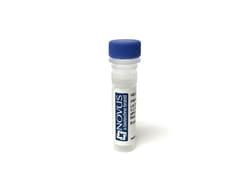p57 Kip2 Antibody (KIP2/880) - IHC-Prediluted, Novus Biologicals™
Manufacturer: Novus Biologicals
Select a Size
| Pack Size | SKU | Availability | Price |
|---|---|---|---|
| Each of 1 | NBP248133-Each-of-1 | In Stock | ₹ 46,636.00 |
NBP248133 - Each of 1
In Stock
Quantity
1
Base Price: ₹ 46,636.00
GST (18%): ₹ 8,394.48
Total Price: ₹ 55,030.48
Antigen
p57 Kip2
Classification
Monoclonal
Conjugate
Unconjugated
Formulation
10mM PBS and 0.05% BSA with 0.05% Sodium Azide
Gene Symbols
CDKN1C
Immunogen
Recombinant full-length human p57 Kip2 protein (Uniprot: P49918)
Purification Method
Protein A or G purified
Regulatory Status
RUO
Primary or Secondary
Primary
Test Specificity
Recognizes a protein of 57kDa, identified as p57Kip2. It shows no cross-reaction with p27Kip1. p57Kip2 is a potent tight-binding inhibitor of several G1 cyclin complexes, and is a negative regulator of cell proliferation. Anti-p57 has been used as an aide in identification of complete hydatidiform mole (CHM) (no nuclear labeling of cytotrophoblasts and stromal cells) from partial hydatidiform mole (PHM) in which both cytotrophoblasts and stromal cells stain. The histological differentiation of complete mole, partial mole, and hydropic spontaneous abortion is problematic. Most complete hydatidiform moles are diploid, whereas most partial moles are triploid. Ploidy studies will identify partial moles, but will not differentiate complete moles from non-molar gestations. Complete moles carry a high risk of persistent disease and choriocarcinoma, while partial moles have a very low risk. In normal placenta, many cytotrophoblast nuclei and stromal cells are labeled with this antibody. Similar findings apply to PHM and hydropic abortus tissues. Intervillous trophoblastic islands (IVTIs) demonstrate nuclear labeling in all three entities and serve as an internal control.
Content And Storage
Store at 4C.
Isotype
IgG2b κ
Applications
Immunohistochemistry (Paraffin)
Clone
KIP2/880
Dilution
Immunohistochemistry-Paraffin
Gene Alias
Beckwith-Wiedemann syndrome, BWS, cyclin-dependent kinase inhibitor 1C, cyclin-dependent kinase inhibitor 1C (p57, Kip2), Cyclin-dependent kinase inhibitor p57, KIP2BWCR, p57, p57Kip2, WBS
Host Species
Mouse
Molecular Weight of Antigen
57 kDa
Quantity
7 mL
Research Discipline
Breast Cancer, Cancer, Cell Cycle and Replication, Core ESC Like Genes, DNA Repair, Stem Cell Markers
Gene ID (Entrez)
1028
Target Species
Human, Mouse
Form
Purified
Related Products
Description
- Description p57 Kip2 Monoclonal specifically detects p57 Kip2 in Human, Mouse samples
- It is validated for Immunohistochemistry, Immunohistochemistry-Paraffin.
